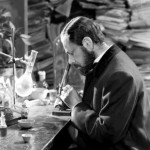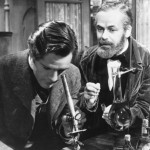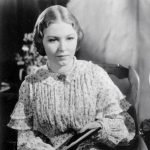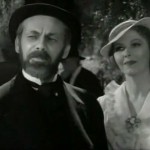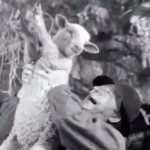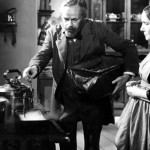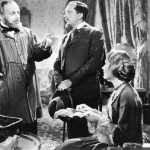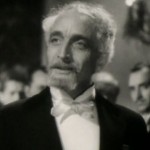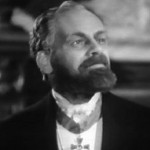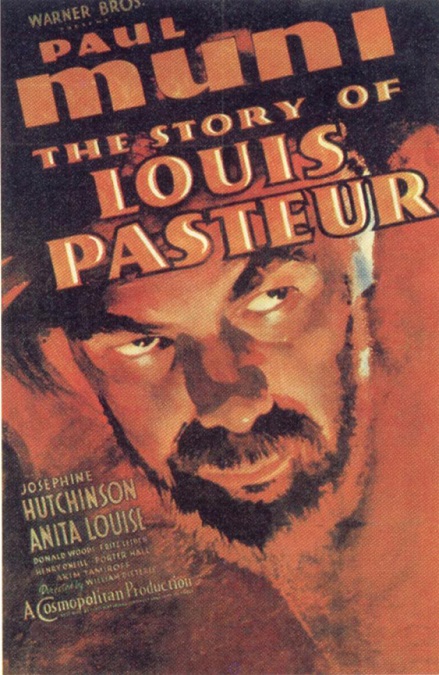
The Story of Luis Pasteur – 1936
It takes a strong man to stand firm in his beliefs when the world is laughing at him. Well, according to this dramatized version of this historical biography, Pasteur is just such a man. And the actor to play him on the screen has to be just as strong to make the character believable. Paul Muni once again proves himself to be an actor of talent and skill. He did a wonderful job as the famous scientist.
Everyone knows that Luis Pasteur was the French chemist that developed the process we know as pasteurization that eliminates deadly microbes from things like wine and milk. But I was not aware that he developed the vaccines that cured anthrax and rabies. I was also not aware that he was so ridiculed by his peers.
Of course, I understand that a little license probably had to be taken with history to make the story a little more dramatic. It is hard to tell. I read up a little on the real Pasteur and could only find information on his remarkable achievements. Very little is given regarding the social climate amongst medical practitioners of the time in France. All the Wikipedia article I read said was that it was not common practice for surgeons to wash their hands or sterilize instruments before performing surgery. However, in the film, Pasteur actually had fellow scientists calling him a quack and taking every opportunity to denounce him as a faker. I would think that if this was really the case, the article would have mentioned it.
Instead it mentioned all the schooling he went through, earning a BA degree. He became a Physics Professor at the college de Tournon at Ardeche and a Chemistry Professor at the University of Strasbourg. Three of his five children died of Typhoid, which motivated him to learn about and combat infectious diseases. Almost none of this was mentioned in the movie.
In the film, Pasteur had a daughter named Annette, played by Anita Louise. She married one of Pasteur’s professional supporters named Matel, played by Donald Woods. In reality, he had a daughter named Marie Louise who married a man named Rene Vallery-Radot. Based on these few things I could find, I suspect that there was a bit of artistic license taken with the film to make it more dramatic. The romance between his daughter and Matel added a bit of a love story to a film that otherwise had no romance at all. Thank you, Hollywood.
Aside from that, the major points in his story seemed to follow reality fairly well. One of the most important things was his treatment of Joseph Meister. A woman had heard of how Pasteur was developing a cure for rabies so she brought her infected son to his home, begging for his help. Pasteur had reservations about treating the boy without a medical license, knowing that if the boy died, he could be tried for murder. He had already successfully tested the vaccine on dogs but never on a human being. But as the boy approached death, he began giving him injections.
In reality, a licensed doctor who was one of Pasteur’s colleagues actually administered the injections under Pasteur’s direction and supervision. This led to his morals and scientific practices to come under scrutiny in later years, even after his death.
But that’s neither here nor there. Paul Muni did a fantastic job. In fact, he won the Best Actor award for the role. The character he played was a bit older than he, himself, was. But he played the scientist very believably. He even realistically portrayed Pasteur after his stroke. Other actors who stood out were Porter Hall as Dr. Rossignol, one of Pasteur’s main critics, Akim Tamiroff as a Russian doctor who supported Pasteur’s work and Anita Louise as Annette Pasteur.
Much like the 1937 Best Picture winner which also starred Paul Muni, The Life of Emile Zola, this was a dramatized biography which actually retained the key events of Pasteur’s story and took some liberties with the details. Imagine my surprise when I found that the two films were directed by the same man, William Deiterie. The format that was common to both films was a good one, but it ultimately made for a slow film. It was mildly interesting, but only because of the changes that were made to make it a more dramatic film.
